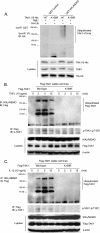Lysine 63-linked polyubiquitination of TAK1 at lysine 158 is required for tumor necrosis factor alpha- and interleukin-1beta-induced IKK/NF-kappaB and JNK/AP-1 activation
- PMID: 20038579
- PMCID: PMC2820763
- DOI: 10.1074/jbc.M109.076976
Lysine 63-linked polyubiquitination of TAK1 at lysine 158 is required for tumor necrosis factor alpha- and interleukin-1beta-induced IKK/NF-kappaB and JNK/AP-1 activation
Abstract
Transforming growth factor-beta-activated kinase 1 (TAK1) plays an essential role in the tumor necrosis factor alpha (TNFalpha)- and interleukin-1beta (IL-1beta)-induced IkappaB kinase (IKK)/nuclear factor-kappaB (NF-kappaB) and c-Jun N-terminal kinase (JNK)/activator protein 1 (AP-1) activation. Here we report that TNFalpha and IL-1beta induce Lys(63)-linked TAK1 polyubiquitination at the Lys(158) residue within the kinase domain. Tumor necrosis factor receptor-associated factors 2 and 6 (TRAF2 and -6) act as the ubiquitin E3 ligases to mediate Lys(63)-linked TAK1 polyubiquitination at the Lys(158) residue in vivo and in vitro. Lys(63)-linked TAK1 polyubiquitination at the Lys(158) residue is required for TAK1-mediated IKK complex recruitment. Reconstitution of TAK1-deficient mouse embryo fibroblast cells with TAK1 wild type or a TAK1 mutant containing a K158R mutation revealed the importance of this site in TNFalpha and IL-1beta-mediated IKK/NF-kappaB and JNK/AP-1 activation as well as IL-6 gene expression. Our findings demonstrate that Lys(63)-linked polyubiquitination of TAK1 at Lys(158) is essential for its own kinase activation and its ability to mediate its downstream signal transduction pathways in response to TNFalpha and IL-1beta stimulation.
Figures









Similar articles
-
TAK1 lysine 158 is required for TGF-β-induced TRAF6-mediated Smad-independent IKK/NF-κB and JNK/AP-1 activation.Cell Signal. 2011 Jan;23(1):222-7. doi: 10.1016/j.cellsig.2010.09.006. Epub 2010 Sep 16. Cell Signal. 2011. PMID: 20837137 Free PMC article.
-
TAK1 Lys-158 but not Lys-209 is required for IL-1β-induced Lys63-linked TAK1 polyubiquitination and IKK/NF-κB activation.Cell Signal. 2011 Apr;23(4):660-5. doi: 10.1016/j.cellsig.2010.11.017. Epub 2010 Dec 3. Cell Signal. 2011. PMID: 21130870 Free PMC article.
-
Polyubiquitination of transforming growth factor β (TGFβ)-associated kinase 1 mediates nuclear factor-κB activation in response to different inflammatory stimuli.J Biol Chem. 2012 Jan 2;287(1):123-133. doi: 10.1074/jbc.M111.285122. Epub 2011 Nov 8. J Biol Chem. 2012. PMID: 22069318 Free PMC article.
-
Ubiquitin-mediated activation of TAK1 and IKK.Oncogene. 2007 May 14;26(22):3214-26. doi: 10.1038/sj.onc.1210413. Oncogene. 2007. PMID: 17496917 Review.
-
Ubiquitin signalling in the NF-kappaB pathway.Nat Cell Biol. 2005 Aug;7(8):758-65. doi: 10.1038/ncb0805-758. Nat Cell Biol. 2005. PMID: 16056267 Free PMC article. Review.
Cited by
-
Deciphering the complexity of Toll-like receptor signaling.Cell Mol Life Sci. 2010 Dec;67(24):4109-34. doi: 10.1007/s00018-010-0464-x. Epub 2010 Jul 31. Cell Mol Life Sci. 2010. PMID: 20680392 Free PMC article. Review.
-
Silencing of Long Noncoding RNA Nespas Aggravates Microglial Cell Death and Neuroinflammation in Ischemic Stroke.Stroke. 2019 Jul;50(7):1850-1858. doi: 10.1161/STROKEAHA.118.023376. Epub 2019 Jun 6. Stroke. 2019. PMID: 31167620 Free PMC article.
-
USP18 inhibits NF-κB and NFAT activation during Th17 differentiation by deubiquitinating the TAK1-TAB1 complex.J Exp Med. 2013 Jul 29;210(8):1575-90. doi: 10.1084/jem.20122327. Epub 2013 Jul 1. J Exp Med. 2013. PMID: 23825189 Free PMC article.
-
Lysine 63-linked ubiquitination modulates mixed lineage kinase-3 interaction with JIP1 scaffold protein in cytokine-induced pancreatic β cell death.J Biol Chem. 2013 Jan 25;288(4):2428-40. doi: 10.1074/jbc.M112.425884. Epub 2012 Nov 21. J Biol Chem. 2013. PMID: 23172226 Free PMC article.
-
Helicobacter pylori activates NF-κB by inducing Ubc13-mediated ubiquitination of lysine 158 of TAK1.J Cell Biochem. 2013 Oct;114(10):2284-92. doi: 10.1002/jcb.24573. J Cell Biochem. 2013. PMID: 23606331 Free PMC article.
References
Publication types
MeSH terms
Substances
Grants and funding
LinkOut - more resources
Full Text Sources
Other Literature Sources
Molecular Biology Databases
Research Materials
Miscellaneous

